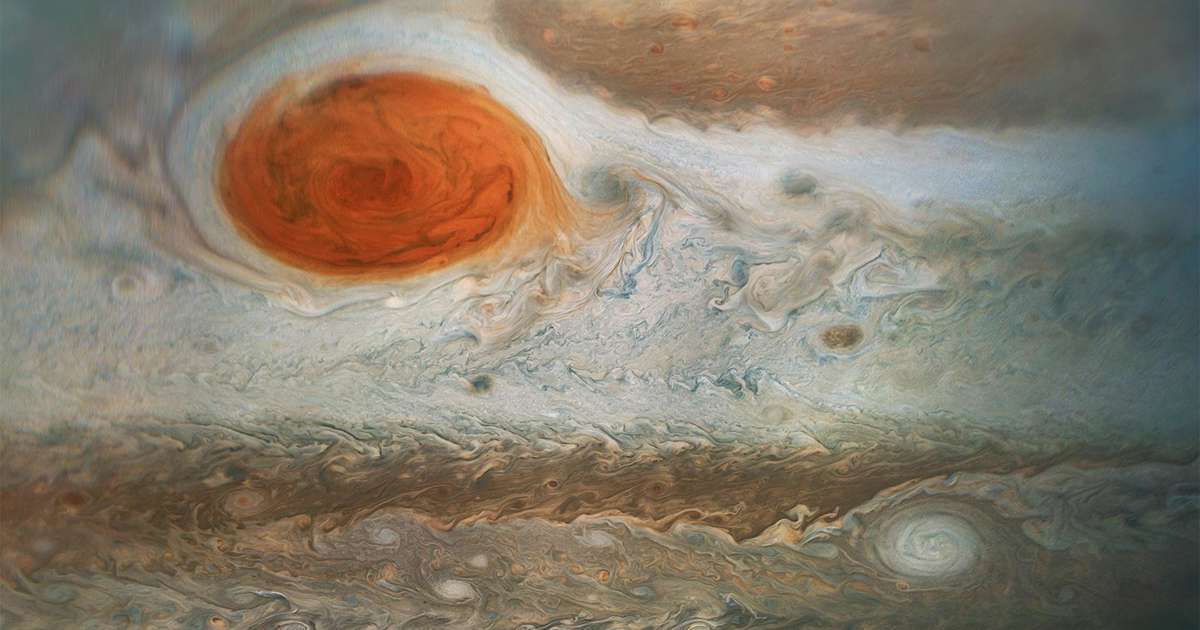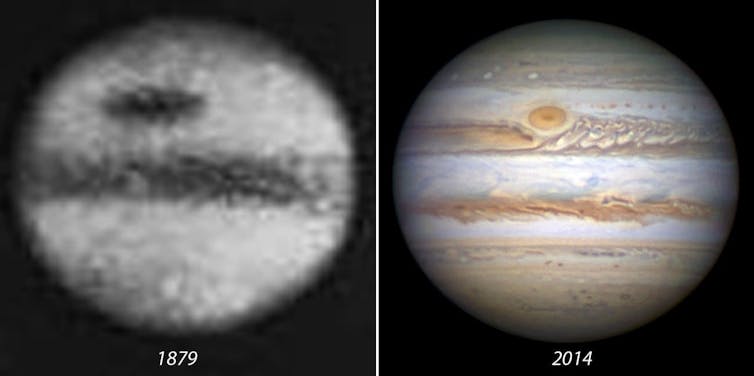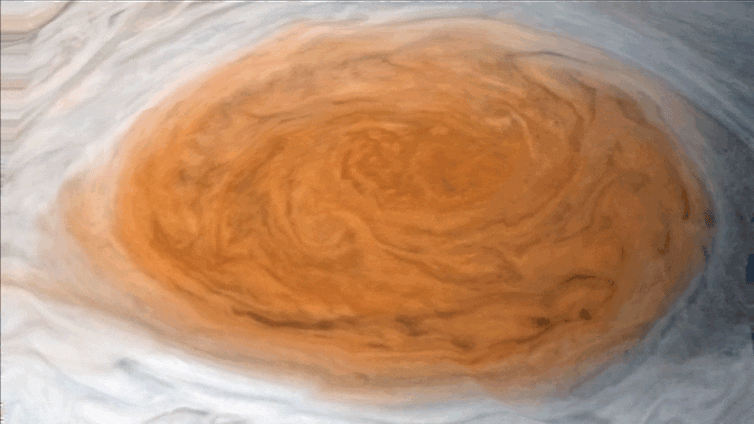Jupiter’s Great Red Spot, the size of Earth, formed 190 years ago.

The MareNostrum supermachine of the Barcelona Supercomputing Centre, capable of processing observational data dating back to the 17th century, together with the support of the computers of the Planetary Science Group in Bilbao, was necessary to unravel the most exotic place in space – a giant reddish anticyclone this makes Jupiter a unique planet. We have now revealed his age and origins.
The Red Spot has, at least for now, a lifespan of over 190 years. In 1879, its dimension along its longest axis was 39,000 km. shrinks while roundingCurrently the mileage is about 14,000 km.

Main tool: supercomputer
The study was carried out in collaboration with researchers from the University of the Basque Country, the Polytechnic University of Catalonia – BarcelonaTech (UPC) and the Barcelona Supercomputing Center – National Supercomputing Center (CNS-BSC). We analyzed historical observations dating back to the 17th century and developed numerical models to explain the longevity and nature of this spectacular meteorological phenomenon in the atmosphere of a gas giant planet. Work published in the magazine Letters on Geophysical Researchfrom the American Geophysical Union.
Huge whirlpool
Jupiter’s Great Red Spot (known as GRS) Great Red Spot), probably the best known atmospheric structure, popular icon among solar system objects.
Its big size (currently the diameter of the Earth) and the contrast of its reddish color with the pale clouds of the planet makes it an object easy to see even with small telescopes. This is a huge anticyclonic vortex, along the periphery of which winds blow at a speed of 450 km/h. This is the largest and longest-lived vortex of all those existing in the atmospheres of the planets of the Solar System, but its age is a subject of debate and controversy. The mechanism that gave rise to its formation remains hidden.
Disappeared for 118 years.
Speculation about the origin of the Great Red Spot dates back to the first telescopic observations by astronomer Giovanni Domenico Cassini, who In 1665, he discovered a dark oval at the same latitude as the Great Red Spot. and he called it “Permanent Spot”. Both Giovanni Domenico and other astronomers observed it before 1713. After that, his trace was lost for 118 years.
In 1831 and in subsequent years, Samuel Heinrich Schwabe again observed at the same latitude a clear, roughly oval-shaped structure, which This can be considered the first observation of the current Great Red Spot.perhaps from the moment it began to form.
Observations since the invention of the telescope
The Great Red Spot has been regularly observed by telescopes and various space missions that have visited the planet to this day.
In the study we analyzed the evolution of size over time, its structure and movement of both meteorological formations, the ancient Permanent Spot and the Great Red Spot. We had historical sources dating back to the mid-17th centuryshortly after the invention of the telescope.
From measurements of size and movement we conclude that It is extremely unlikely that the current Red Spot is the same one observed by J.D. Cassini. The permanent spot was probably not permanent at all and disappeared sometime between the mid-18th and 19th centuries.
Thus, the Red Spot we see on Jupiter today It is at least 190 years old and has shrunk in size. In 1879, its size along the longest axis was 39,000 km, and then it decreased, rounding up, and reached the current 14,000 km.
500 kilometers vertical
Since the 1970s, various space missions have closely studied this meteorological phenomenon. Various instruments aboard NASA’s Juno mission orbiting Jupiter have revealed that the Great Red Spot It is shallow and thin compared to its horizontal size.since vertically it extends approximately 500 km.
To find out how this huge vortex could have formedWe carried out numerical simulations on Spanish supercomputers such as the MareNostrum IV BSC, integrated in the Spanish Supercomputing Network (RES), and the supercomputers of the Planetary Science Group in Bilbao, using two types of complementary models of the behavior of thin vortices in the atmosphere of Jupiter.
In the center of the Great Red Spot
On the giant planet they dominate intense wind currents flowing along parallels alternating your direction with latitude. North of the Great Red Spot, winds blow to the west at 180 km/h, while in the south they blow in the opposite direction, to the east, at 150 km/h. This results in a huge shift in wind speed from north to south, which main ingredient for vortex growth inside.
We investigated various mechanisms that explain the origin of the Great Red Spot, including giant superstorm eruptionsimilar to those very rarely observed on the twin planet Saturn, or the merger of many smaller vortices resulting from wind shear.
On Saturn, emissions of convective storms in shear flows of anticyclones generate oval vortices. An important case was the recent major storm (Great White Spot GWS 2010), which gave rise to an anticyclone that still exists today..
We studied whether Jupiter’s Great Red Spot could similarly have been created by a wet, energetic convective “superstorm” on Jupiter. Our simulations generate one oval anticyclone, but Its length is always less than that which could give rise to the formation of the Great Red Spot.
Increasing the intensity, size, and duration of injections of energy and mass results in the appearance of impossibly round ovals and rotation rates far exceeding those observed in today’s Great Red Spot. It has also been suggested that anticyclones may arise from deep convection caused by Jupiter’s internal energy, but The published simulations do not look like what we are looking for.
The results show that although an anticyclone forms in both cases, it differs in its shape and dynamic properties from the current Great Red Spot. We think that if one of these unusual phenomena occurred, it would certainly its effects in the atmosphere would have been noticed and has been reported by astronomers previously.
Wind instability
In the third group of numerical experiments, we investigated the emergence of the Great Red Spot as a result of the known instability of winds. This instability is capable of forming an elongated cell that surrounds and holds them. This cell could be the proto-Great Red Spot, the embryo of an anticyclone. Its subsequent compression would lead to the formation of the compact and rapidly rotating Great Red Spot, which has been observed since the late 19th century.

The formation of large elongated cells has already been observed during the emergence of other important vortices on Jupiter. In our simulations, we found that elongated cells They are stable when rotating around their periphery at the speed of Jupiter’s winds. We found that if the rotation speed of the proto-GRS is lower than the surrounding winds, it fragments, making it impossible for a stable vortex to form. And if it is very high, then its properties differ from the properties of the current gas distribution system.
Future research will focus on try to reproduce why it decreased over time. We will also try to find out whether it will end one day, whether it will decay and disappear when it reaches its limiting size, as might have happened with the Permanent Spot observed by Cassini, or whether it will stabilize and last for many more years. .![]()
Agustin Sánchez Lavega, specialist in applied physics, School of Engineering Bilbao UPV/EHU, University of the Basque Country / Euskal Herrico Unibertsiatea
This article was originally published on The Conversation. Read the original.